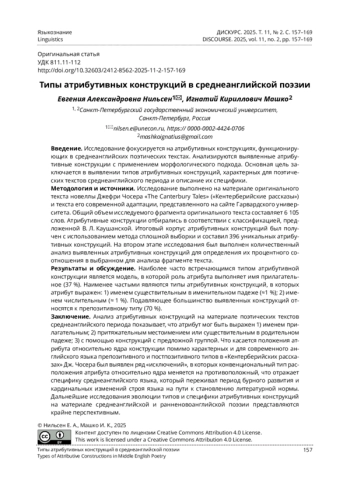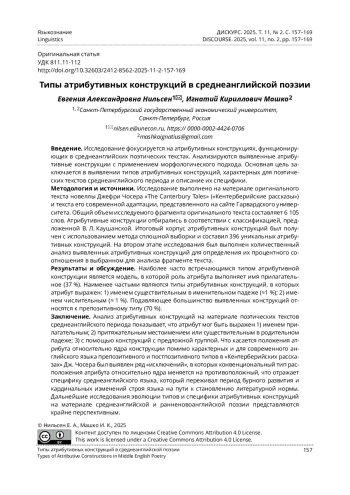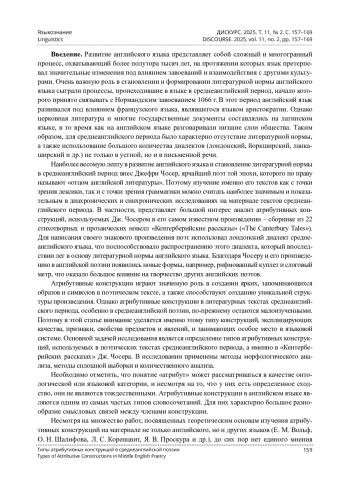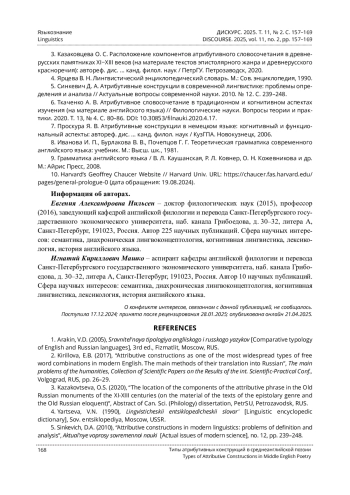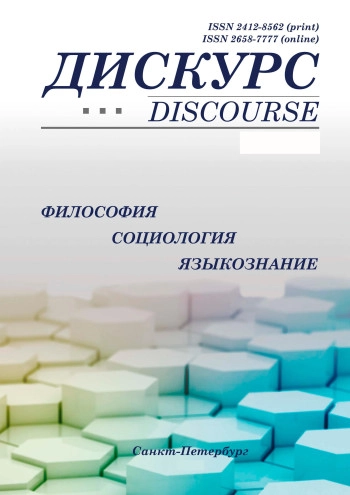Введение. Исследование фокусируется на атрибутивных конструкциях, функционирующих в среднеанглийских поэтических текстах. Анализируются выявленные атрибутивные конструкции с применением морфологического подхода. Основная цель заключается в выявлении типов атрибутивных конструкций, характерных для поэтических текстов среднеанглийского периода и описание их специфики. Методология и источники. Исследование выполнено на материале оригинального текста новеллы Джефри Чосера «The Canterbury Tales» («Кентерберийские рассказы») и текста его современной адаптации, представленного на сайте Гарвардского университета. Общий объем исследуемого фрагмента оригинального текста составляет 6 105 слов. Атрибутивные конструкции отбирались в соответствии с классификацией, предложенной В. Л. Каушанской. Итоговый корпус атрибутивных конструкций был получен с использованием метода сплошной выборки и составил 396 уникальных атрибутивных конструкций. На втором этапе исследования был выполнен количественный анализ выявленных атрибутивных конструкций для определения их процентного соотношения в выбранном для анализа фрагменте текста. Результаты и обсуждение. Наиболее часто встречающимся типом атрибутивной конструкции является модель, в которой роль атрибута выполняет имя прилагательное (37 %). Наименее частыми являются типы атрибутивных конструкций, в которых атрибут выражен: 1) именем существительным в именительном падеже (≈1 %); 2) именем числительным (≈ 1 %). Подавляющее большинство выявленных конструкций относятся к препозитивному типу (70 %). Заключение. Анализ атрибутивных конструкций на материале поэтических текстов среднеанглийского периода показывает, что атрибут мог быть выражен 1) именем прилагательным; 2) притяжательным местоимением или существительным в родительном падеже; 3) с помощью конструкций с предложной группой. Что касается положения атрибута относительно ядра конструкции помимо характерных и для современного английского языка препозитивного и постпозитивного типов в «Кентерберийских рассказах» Дж. Чосера был выявлен ряд «исключений», в которых конвенциональный тип расположения атрибута относительно ядра меняется на противоположный, что отражает специфику среднеанглийского языка, который переживал период бурного развития и кардинальных изменений строя языка на пути к становлению литературной нормы. Дальнейшие исследования эволюции типов и специфики атрибутивных конструкций на материале среднеанглийской и ранненовоанглийской поэзии представляются крайне перспективным.
Introduction. The research focuses on attributive constructions functioning in Middle English poetic texts. The analysis of the identified attributive structures using a morphological approach is carried out. The main aim is to identify the types of attributive constructions characteristic of poetic texts of the Middle English period and describe their peculiarities. Methodology and sources. The research is carried out on the material of the original text of Geoffrey Chaucer’s ‘The Canterbury Tales’ and the text of its modern adaptation, presented on the website of Harvard University. The total volume of the investigated fragment of the original text is 6105 words. Attributive constructions were selected in accordance with the classification proposed by V. L. Kaushanskaya. The final corpus of attributive constructions was obtained using the method of continuous sampling and totalled 396 unique attributive constructions. At the second stage of the study, quantitative analysis of the identified attributive constructions was carried out in order to determine their percentage ratio in the text fragment selected for analysis. Results and discussion. The most frequent type of attributive construction is the model in which the role of the attribute is performed by the adjective (37 %). The least frequent are the types of attributive constructions in which the attribute is expressed by: 1) a noun in the nominative case (≈ 1 %); 2) a numeral (≈ 1 %). The vast majority of the identified constructions belong to the prepositional type (70 %). Conclusion. The analysis of attributive constructions based on the material of poetic texts of the Middle English period shows that the attribute could be expressed: 1) by an adjective; 2) by a possessive pronoun or noun in the genitive case; 3) using constructions with a prepositional group. As for the position of the attribute relative to the core of the construction, in addition to the prepositive and postpositive types characteristic of Modern English, a number of “exceptions” were identified in G. Chaucer’s “Canterbury Tales” in which the conventional type of the attribute relative to the core is reversed, which reflects the specifics of the Middle English language, which was experiencing a period of rapid development and cardinal changes in the structure of language on the way to the formation of the literary norm. Further studies on the evolution of types and peculiarities of attributive constructions based on the material of Middle English and Early Modern English poetry seem extremely promising.
Идентификаторы и классификаторы
Введение. Развитие английского языка представляет собой сложный и многогранный процесс, охватывающий более полутора тысяч лет, на протяжении которых язык претерпевал значительные изменения под влиянием завоеваний и взаимодействия с другими культурами. Очень важную роль в становлении и формировании литературной нормы английского языка сыграли процессы, происходившие в языке в среднеанглийский период, начало которого принято связывать с Нормандским завоеванием 1066 г. В этот период английский язык развивался под влиянием французского языка, являвшегося языком аристократии. Однако церковная литература и многие государственные документы составлялись на латинском языке, в то время как на английском языке разговаривали низшие слои общества. Таким образом, для среднеанглийского периода было характерно отсутствие литературной нормы, а также использование большого количества диалектов (лондонский, йоркширский, ланкаширский и др.) не только в устной, но и в письменной речи.
Список литературы
1. Аракин В. Д. Сравнительная типология английского и русского языков: учеб. пособие. 3-е изд. М.: ФИЗМАТЛИТ, 2005. EDN: UGLMZP
2. Кириллова Е. Б. Атрибутивные конструкции как один из наиболее распространенных типов свободных словосочетаний в современном английском языке. Основные приемы их перевода на русский язык // Основные проблемы гуманитарных наук: сб. науч. тр. по итогам Междунар. науч.-практ. конф., Волгоград, 11 октября 2017 г. Вып. 4 / ИЦРОН. Волгоград, 2014. С. 26-29.
3. Казаковцева О. С. Расположение компонентов атрибутивного словосочетания в древнерусских памятниках XI-XIII веков (на материале текстов эпистолярного жанра и древнерусского красноречия): автореф. дис. … канд. филол. наук / ПетрГУ. Петрозаводск, 2020. EDN: OXPNQP
4. Ярцева В. Н. Лингвистический энциклопедический словарь. М.: Сов. энциклопедия, 1990. EDN: RXSTYX
5. Синкевич Д. А. Атрибутивные конструкции в современной лингвистике: проблемы определения и анализа // Актуальные вопросы современной науки. 2010. № 12. С. 239-248.
6. Ткаченко А. В. Атрибутивное словосочетание в традиционном и когнитивном аспектах изучения (на материале английского языка) // Филологические науки. Вопросы теории и практики. 2020. T. 13, № 4. С. 80-86. DOI: 10.30853/filnauki.2020.4.17 EDN: AMBTMV
7. Проскура Я. В. Атрибутивные конструкции в немецком языке: когнитивный и функциональный аспекты: автореф. дис. … канд. филол. наук / КузГПА. Новокузнецк, 2006. EDN: ZNRKEZ
8. Иванова И. П., Бурлакова В. В., Почепцов Г. Г. Теоретическая грамматика современного английского языка: учебник. М.: Высш. шк., 1981.
9. Грамматика английского языка / В. Л. Каушанская, Р. Л. Ковнер, О. Н. Кожевникова и др. М.: Айрис Пресс, 2008.
10. Harvard’s Geoffrey Chaucer Website // Harvard Univ. URL: https://chaucer.fas.harvard.edu/pages/general-prologue-0 (дата обращения: 19.08.2024).
Выпуск
Другие статьи выпуска
Введение. В фокусе внимания в настоящей статье находится английский язык в его различных функциях: как национальный язык, как средство международного и межкультурного обмена, как инструмент практической коммуникации носителей других языков, а также как источник разнообразных исследовательских программ, связанных с этими функциональными разновидностями языка. Цель исследования заключается в создании структурированного обзора исследований отмеченных функциональных разновидностей английского языка в рамках таких исследовательских направлений, как контактная вариантология (World Englishes, WE), глобальный английский (Global English, GE), английский как лингва франка (English as a Lingua Franca, ELF) и английский как международный язык (English as an International Language, EIL). Методология и источники. Эмпирическая база исследования основана на данных за период 2008-2024 гг., полученных из основной коллекции Web of Science, которые были проанализированы с использованием программы Citespace для визуализации тенденций и паттернов в изучаемой области. Результаты и обсуждение. Результаты показывают, что исследования в области WE, GE, ELF и EIL характеризуются междисциплинарным и межинституциональным сотрудничеством. Признание полицентрического характера современного английского языка привело к повышению статуса его вариантов, чьи фонетические характеристики и прагматические функции постепенно интегрируются в образовательные программы. Заключение. Проведенное исследование показало стабильный рост исследовательского интереса к проблеме вариативности английского языка, результатом которого стали положительные сдвиги в рецепции и позиционировании национальных вариантов как в теоретическом, так и прикладном поле. Тем не менее остаются нерешенные проблемы и «слепые зоны», также выявленные в ходе исследования.
Введение. Статья посвящена определению содержательного ядра синонимических рядов англоязычных терминов в области строительной техники как одному из методов исследования данной терминосистемы с точки зрения ее особенностей и структуры. Актуальность работы обусловлена возрастающей потребностью в изучении терминосистемы «Строительная техника» в целях подготовки специалистов, обладающих компетенциями в области проектирования, ремонта, модернизации, а также эксплуатации строительных машин, поступающих на территорию РФ из-за границы. Основанием для исследования также послужило отсутствие когнитивных исследований, касающихся терминосистемы «Строительная техника». Методология и источники. Методологической базой исследования послужили: опрос, корпусный, дефиниционный и сравнительный анализы. Автором применяется квантитативный подход для приведения статистических данных, необходимых для демонстрации некоторых результатов исследования. Настоящее исследование также опирается на концепции Д. С. Лотте в области синонимии в технической терминологии, а также И. К. Архипова в определении понятия «Содержательное ядро». В качестве источников были использованы руководства по эксплуатации для таких видов строительной техники, как гидравлический экскаватор, фронтальный погрузчик, экскаватор-погрузчик. Опрос проходил 10.07.2024 г. в компании «АТЛЕТ», в опросе участвовало 57 специалистов, обладающих необходимыми компетенциями в области строительной техники. Результаты и обсуждение. В ходе данного исследования гипотеза: «Если содержательное ядро выбранного термина-доминанты синонимического ряда совпадает с содержательным ядром всего синонимического ряда, то этот факт может являться основанием для определения данной доминанты как таковой», не подтвердилась. Заключение. Терминосистема «Строительная техника» является малоизученной с точки зрения когнитивного подхода на данном этапе. В связи с этим в процессе исследования могут быть выявлены различного рода трудности, замедляющие процесс поиска ответа на вопрос о характере и особенностях данной терминосистемы. Исследование стало попыткой автора выявить некоторые противоречия, возникающие в процессе исследования строительно-технической терминологии и осветить их для широкого круга профессионалов, в чью область интересов входит когнитивное терминовдение.
Введение. Статья рассматривает роль агента терапевтического воздействия и анализирует особенности дискурсов помогающих профессий (психолога, психотерапевта, врача, педагога, шамана, адвоката) в современных практиках работы с клиентами, нуждающимися в различных видах помощи. Цель статьи заключается в анализе разновидностей языка дискурсов помогающих профессий. Российский лингвист В. И. Карасик включает медицинский дискурс как вид институционального, а психотерапевтический дискурс рассматривает как разновидность медицинского. Между тем психотерапевтический дискурс вполне можно рассматривать как отдельный вид дискурса. На современном этапе развития дискурс-анализа назрела необходимость взаимодополнения тактик и языковых подходов к клиентам в дискурсах помогающих профессий в связи с новой парадигмой естественных наук - комплексным рассмотрением человека как существа биосоциального, массового, космического. Отсюда актуализировался интерес к древнейшим архаическим типам помогающих профессий и типов дискурса - магическому, медитативному, религиозному. Методология и источники. Статья базируется на основных положениях теорий В. И. Карасика и Тэна ван Дейка. Методологической основой проведенного автором анализа стали научные труды, посвященные дискурсу психотерапевтическому (А. Р. Маркин, М. С. Гринева, Е. В. Ермолаева), медицинскому (М. Фуко, О. А. Шестерикова, В. В. Жура, В. Г. Силантьева), адвокатскому (М. Фуко, В. Г. Ищенко, М. С. Медведева, С. А. Зимина), педагогическому (Е. Т. Булгакова, К. А. Возмищева, Л. М. Осиновская), магическому (Г. Стормс и Ф. Грендон, Е. Г. Ермолаева, М. Л. Камерон), медитативному (М. Г. Еремченко, О. А. Дмитриева, Е. Н. Мельникова). Результаты и обсуждение. Дается характеристика и выделяется специфика различных типов дискурсов помогающих профессий, описываются особенности языковых техник, которые применяются в этих дискурсах в зависимости от целей воздействия на клиента.
Заключение. В ходе исследования показана специфика дискурсов помогающих профессий, связанная прежде всего с целями и задачами в разных культурах и неоднозначных ситуациях терапевтической практики.
Введение. Интернет-мем является одним из ключевых элементов современной медиакоммуникации. Цель настоящей статьи заключается в проведении аналитического обзора существующих подходов к исследованию понятия интернет-мема. Актуальность исследования определяется необходимостью комплексного описания интернет-мема с учетом непрерывной эволюции данного феномена. Методология и источники. Методологической базой исследования послужили работы в области когнитивной лингвистики, философии, медиакоммуникаций, рассматривающие развитие и функционирование мемов в динамике. Основным методом исследования является аналитический обзор трудов, посвященных толкованию и типологизации интернет-мемов, а также определению функций и роли интернет-мема в социокультурном пространстве и интернет-коммуникации. Результаты и обсуждение. Анализ работ зарубежных и отечественных исследователей демонстрирует целесообразность разграничения терминов «мем» и «интернет-мем». Интернет-мем как поликодовый текст является одним из аспектов многогранного концепта «мем», однако данным терминологическим различием нередко пренебрегают. Роль интернет-мема состоит в демонстрации актуальных изменений в языке на всех его уровнях. Существует необходимость унифицирования толкования и типологизации интернет-мемов, что представляет определенную сложность по причине изменчивости и нестабильности данного явления. К наиболее продуктивным методам исследования интернет-мема относятся цифровой и визуальный анализ. В рамках лингвистических исследований актуальными фреймворками для анализа и типологизации интернет-мемов видятся дискурс-анализ и грамматика конструкций, учитывающая изменчивость и мультимодальную структуру мемов. Одним из приоритетных направлений исследований в русле лингвокогнитивного подхода является дальнейшая разработка типологий интернет-мемов с учетом области их функционирования и постоянно меняющихся трендов в образовании мемов. Заключение. К перспективам исследования интернет-мемов можно отнести осмысление интертекстуальности и рассмотрение механизмов реутилизации старых мемов. Быстрая изменчивость вербальной и невербальной составляющей интернет-мемов, высокочастотное использование интертекстуальных отсылок и намеренно искаженных лексических и грамматических структур делают актуальным изучение функционирования интертекста и формирования продуктивных моделей и языковых шаблонов в интернет-мемах.
Введение. Освоение студентами инженерных специальностей технологий управленческого общения выступает одним из важных условий построения карьеры. Но далеко не все выпускники инженерных факультетов обладают такими практическими навыками. В значительной степени это обстоятельство обусловлено отсутствием методик диагностики успешности освоения этих методов. Методология и источники. Теоретическая рамка методики эмпирического исследования выстраивается на идеях интеракционистских концепций общения, включающих работы И. Гофмана, Д. Мида и Г. Гарфинкеля, а также теорий ритуального взаимодействия Р. Коллинза и эмоционального интеллекта Д. Тернера. В качестве базового инструментария технологии диагностики использован опросник В. Дж. Редди, который адаптирован под интересы исследования. Результаты и обсуждение. Полученные результаты могут быть представлены тремя основными выводами: во-первых, наибольшее единство восприятия методов управленческой коммуникации характеризует стремление обеспечивать эмоциональный комфорт общения; во-вторых, следующий уровень единства в восприятии технологий общения ориентирован на рациональное лидерство; в-третьих, низший уровень единства включает спорные приемы общения, которые по-разному понимаются респондентами. Заключение. Формирование методики диагностики технологий управленческого общения имеет хорошую перспективу в отношении диагностики особенностей общения студентов различных профилей подготовки, а также особенностей восприятия управленческого общения студентами из разных стран, обучающихся в российских университетах.
Введение. Институализация социальных медиа как главного коммуникативного пространства современности очевидным образом способствовала вовлечению политических партий в новые форматы взаимодействия с аудиторией. Распространение популизма, ставшее возможным благодаря новым технологиям, сегодня можно рассматривать как разновидность агрессивного интернет-продвижения партийных лозунгов и идеологий. Развитие и совершенствование подобных методов воздействия на электорат остается актуальной проблемой, требующей научного анализа. В настоящей статье предметом исследования стали особенности использования социальных медиа в политических коммуникациях правых партий Швеции. Методология и источники. Теоретико-методологической базой исследования послужили функциональный (К. Лоусон) и идеологический (К. фон Бейме) подходы к исследованию политических партий. Эмпирические данные, собранные в онлайн-сообществах, обрабатывались с помощью качественно-количественного контент-анализа. Для сбора информации на языке Python был написан программный продукт, взаимодействующий с интернет-ресурсами при помощи библиотек requests и pandas. Полученные данные позволили рассчитать коэффициент вовлеченности (ER) и коэффициент привлекательности онлайн-сообществ (LR) для фиксации обратной связи на публикации. Результаты и обсуждение. В контексте политических событий 2021-2022 гг. партии «Шведские демократы» и «Христианские демократы» концентрировались на популистской повестке, затрагивая проблемы преступности, кризиса мультикультурализма, последствий эпидемии Covid-19 и недовольства общества миграционной политикой, что в итоге привело к росту популярности правоконсервативных партий, о чем свидетельствуют результаты парламентских выборов 2022 г. Заключение. Комплексный анализ содержания онлайн-сообществ шведских правых партий позволил изучить цифровые следы публикаций в социальных медиа, а также выявить и ранжировать по частоте лексемы, используемые для воздействия на аудиторию. На основании полученных сведений были выявлены техники влияния, способствовавшие росту интереса шведского электората к правоконсервативным идеям.
Введение. В статье анализируется относительно новая форма досуга для людей старшего возраста: участие в качестве моделей на показах мод. Под старшими, согласно действовавшему на момент проведения интервью пенсионному законодательству РФ, подразумеваются женщины и мужчины после 55 и 60 лет соответственно.
Цель: показать возможности, способствующие активному долголетию, которые проявляются благодаря участию в показах мод. Методология и источники. Всего было проведено 32 интервью с москвичами старшего возраста, принимающими/принимавшими когда-либо участие в программе «Московское долголетие». У автора не было задачи получить информацию об их увлечении модой и участии в модных показах, не было и ни одного вопроса, затрагивающего данную тематику. Но ответы периодически возникали сами. Также проводился вторичный анализ имеющихся публикаций по теме исследования, сравнительный анализ и обобщение данных, анализ статистики. Результаты и обсуждение. В ходе интервью с людьми старшего возраста автор зафиксировал возможности, способствующие активному долголетию, которые проявляются благодаря увлечению модой. Многочасовые репетиции, постоянные занятия и тренировки модельного шага положительно сказываются на осанке и фигуре, помогают похудеть и даже улучшить здоровье. Снятие зажимов в теле и приобретение навыков фотопозирования способствуют новому восприятию себя и большей уверенности, мотивируют развиваться. Появляется новый стиль и красивые фотографии как память о проведенном времени; проявляются творческие качества и формируется сообщество по интересам. Люди старшего возраста ощущают свою важность, нужность, видимость для общества, признаются, что исполнили мечту детства, юности. Заключение. Информанты отмечали, что стали выглядеть и чувствовать себя моложе. Полученные навыки и первые результаты по ощущению себя другими, не такими, как в обычной жизни, задают вектор дальнейшего развития, появляются новые планы и жизненные горизонты, способствующие активному долголетию.
Введение. В статье представлено обоснование выделения в исследованиях коммуникации «человек - машина» особой предметной области - изучение ее как социального ролевого взаимодействия. Формулируются ключевые положения описания реляционного механизма возникновения социальных ролей в исполнении агентов коммуникации «человек - машина». Привлекаются данные об экспертизах применения технологий с искусственным интеллектом в коммуникации человека с машинами. Методология и источники. Исследование основано на реляционной парадигме объяснения природы феномена социальных ролей в коммуникации человека и машины, возникающих и конструируемых исключительно в пространстве их взаимодействий. Для концептуализации предлагаются понятия социальной роли, симуляции роли, имитации роли, подражания, уподобления, реляции, ситуативного действия. В качестве источников использованы экспертные отчеты об исследовании коммуникаций человека с устройствами искусственного интеллекта. Результаты и обсуждение. Установлено, что социальные роли человека и функции машины формируются в процессе взаимной симуляции, имитации, подражания и уподобления с учетом ситуации. Человек как коммуникатор включен в исполнение двух ролей, но исполняет одну из них, возникающую в коммуникации. Две роли объединены в одну - социальную роль, которую могут исполнять только оба участника совместно и в особом гибридном формате коммуникации. Природа социальности этих ролей - в ситуации коммуникации. Заключение. Реляционный механизм возникновения социальных ролей в исполнении человека и машины проявляется в изменении поведения человека и модификации функций машины. При исполнении социальных ролей происходит техноморфизация поведения человека и антропо(социо)морфизация функционирования машины. Человек переосмысливает роль коммуникатора, меняя ее значение при контакте с технической формой активности машины-коммуникатора. Роль превращается в синтез антропо- и техноморфных проявлений. Машина начинает присутствовать как агент и заявляет о себе требованиями учитывать свою специфику. Человек стремится не потерять социальное основание ее поведения и одновременно вынужден адаптироваться к опциям машины.
Введение. Фактически любая мировоззренческая или методологическая конструкция представляет собой определенную систему знания, включающую исходные понятия, правила построения высказываний и выводы производных суждений, которые после необходимого обсуждения и подтверждения приобретают форму всеобщего убеждения. Подобным критериям соответствует методология разработки единых пролегоменов в описании современного образовательного пространства, заявленных в мировой социально-политической философии и в философии образования. Эта необходимость требует выяснения того, как и каким образом с помощью рациональной философской мысли возможно и необходимо разработать методологию, объединяющую категориальный аппарат многочисленных образовательных систем. Методология и источники. Описание единых категориальных основ образовательного пространства осуществляется в онтологическом, эпистемологическом и аксиологическом содержании приоритетов, представленных современным пространством образования. Результаты и обсуждение. Методология глобализма в социальной философии и философии образования теоретически организована и иерархизирована. В целом она включает в себя интересы и потребности, смыслы и ценности субъектов познания. Обнаружение фундаментальных ориентиров в онтологических, эпистемологических и аксиологических приоритетах философско-образовательного дискурса в вопросах построения глобального образовательного пространства вызывает необходимость критической философской оценки глобализационных теоретико-методологических подходов с точки зрения социо-ноосферной методологии познания. Это важно при разработке единых категориальных основ в описании образовательного пространства. Заключение. Методологический потенциал философии образования как гуманистической основы развития человечества обладает высокой эвристической значимостью в аспекте диалектики медиапространства с возможностями интегрированного в него образования. Единое категориальное пространство, оформленное в методологии онтологии, эпистемологии и аксиологии образования, в практической реализации способно проектироваться в массовом мировосприятии, миропонимании и мировоззрении, основанных на углубленной разработке социо-ноосферной методологии образовательного пространства.
Введение. В статье обосновывается возможность применения семиологического анализа по отношению к идеологии на основе семиологической теории Р. Барта. Предметом исследования является идеология как знаковая система. Научная новизна исследования заключается в применении семиологического анализа к идеологии. Гипотеза исследования состоит в том, что идеология является знаковой системой, подобной мифологии. Методология и источники. Методология исследования основывается на семиологической теории Р. Барта. Для анализа идеологии и ее влияния на общество и социальной действие используются социальные теории К. Маркса и Т. Парсонса. Результаты и обсуждение. Влияние идеологии на общество и социальное действие является свершившимся фактом. Идеология в данном исследовании определяется как совокупность идей и убеждений, выражающих интересы определенных социальных групп. Идеология является таким знанием, которое имеет политический и социально-практический характер. Идеологические ценности и нормы являются неотъемлемой частью поведения социальных групп в обществе и определяют его. Семиологическое измерение идеологии представляет собой выражение таких норм и ценностей в социальном пространстве и коммуникациях. В статье дается интерпретация социального действия с учетом идеологических установок, которые определяют его политический характер. Заключение. Основной вывод этого исследования заключается в том, что идеология воплощается в социальном пространстве и служит инструментом объяснения интересов тех или иных социальных групп, на основе чего формируется соответствующая семиология, специфически свойственная акторам социального действия. Значение и смысл идеологических норм и ценностей в обществе, являясь неотъемлемой составляющей социального действия, выражаются при помощи идеологической семиологии.
Ведение. Статья посвящена проблеме соотношения моральной и эпистемической ответственности. В качестве конкретного примера концепции, рассматривающей взаимосвязь двух исследуемых форм ответственности, приводится «принцип недоверия помыслам», формулирующийся в статьях А. С. Мишуры и С. М. Левина. Цель статьи - проанализировать этот принцип и аргументацию в его пользу, а также прояснить разграничение между моральной и эпистемической ответственностью. Методология и источники. Автор использует метод концептуального анализа для решения поставленной исследовательской задачи. К главным источникам работы относятся статьи А. С. Мишуры и С. М. Левина. К вспомогательным источникам относятся работы авторов, принадлежащих к аналитической философской традиции. Результаты и обсуждение. В статье проанализированы две возможные формы ответственности: эпистемическая и моральная. Рассмотрены два возможных типа определений слова «ответственность»: дескриптивный предполагает формулировку условий, необходимых для возможности реакции на действия или убеждения агента, прескриптивный включает в себя критерии оценки агента, его действий или убеждений как заслуживающих поощрения или порицания. Принцип недоверия помыслам, поддерживаемый А. С. Мишурой и С. М. Левиным, предполагает, что в определенных ситуациях морально ответственно отбрасывать свидетельства в пользу истинности некоторых убеждений. Слабым местом анализируемых статей являются примеры, которые не способствуют прояснению причинно-следственной связи между истинным убеждением и морально порочным поступком. Заключение. В статье высказывается сомнение в том, что А. С. Мишуре и С. М. Левину удалось ясно и убедительно продемонстрировать взаимосвязь между истинными убеждениями агента и его морально порочными поступками. С точки зрения автора, приведенные С. М. Левиным примеры могут быть сведены к выбору между альтернативными трактовками моральной ответственности, а не выбором между моральной и эпистемической ответственностью.
Введение. В статье исследуются условия относительно высокой/низкой лояльности «подчинённых» (субъектов лояльности) к «начальству» (объектам лояльности) в различных институциональных контекстах. Лояльность рассматривается как переменная, включающая различные уровни поддержки или оспаривания подчиненными власти начальства. На основе неовеберианского подхода выдвинута гипотеза о факторах, укрепляющих лояльность: чем сильнее властная инстанция обеспечивает базовые социальные заботы подчиненных - безопасность, социальный статус и доход - тем выше их лояльность. Методология и источники. Условия лояльности исследуются сопоставлением контрастных случаев высокой (остзейское рыцарство, сибирское и позднее донское казачество, белорусская позднесоветская элита) и низкой лояльности (яицкое и раннее донское казачество, ранняя грузинская аристократия, литовская позднесоветская элита). Результаты и обсуждение. Базовые социальные заботы обеспечиваются структурами трех типов: а) иерархические военно- и гражданско-бюрократические институты; б) патрон-клиентские сети; в) самоуправляющиеся эгалитарные сообщества. Социализация в военно-бюрократических институтах государственной службы обеспечивает относительно высокий уровень лояльности по отношению к государственной власти и является наиболее предпочтительной для элит. Предпочтение представителями элит патрон-клиентских сетей и эгалитарных сообществ вызвано издержками военно-бюрократических институтов, в частности, дефицитом престижных позиций. Распространение престижного потребления как демонстрации высокого статуса, сохранение приемлемого для элит уровня благополучия, престижа и безопасности после выхода в отставку помимо служебного жалования снижают эти издержки. Заключение. Уровень лояльности субъектов по отношению к объектам лояльности тем выше, чем меньше срок пребывания на престижных позициях, выше культурная, социальная, лингвистическая дистанция между субъектами лояльности и социальным окружением, а уровень влияния, власти, богатства отдельных субъектов лояльности существенно ниже, чем у объекта лояльности.
Статистика статьи
Статистика просмотров за 2025 год.
Издательство
- Издательство
- СПБГЭТУ ЛЭТИ
- Регион
- Россия, Санкт-Петербург
- Почтовый адрес
- 197022, улица Профессора Попова, дом 5, литера Ф.
- Юр. адрес
- 197022, г Санкт-Петербург, Петроградский р-н, ул Профессора Попова, д 5 литера ф
- ФИО
- Шелудько Виктор Николаевич (РЕКТОР)
- E-mail адрес
- rector@etu.ru
- Контактный телефон
- +7 (812) 2344651
- Сайт
- https://etu.ru
